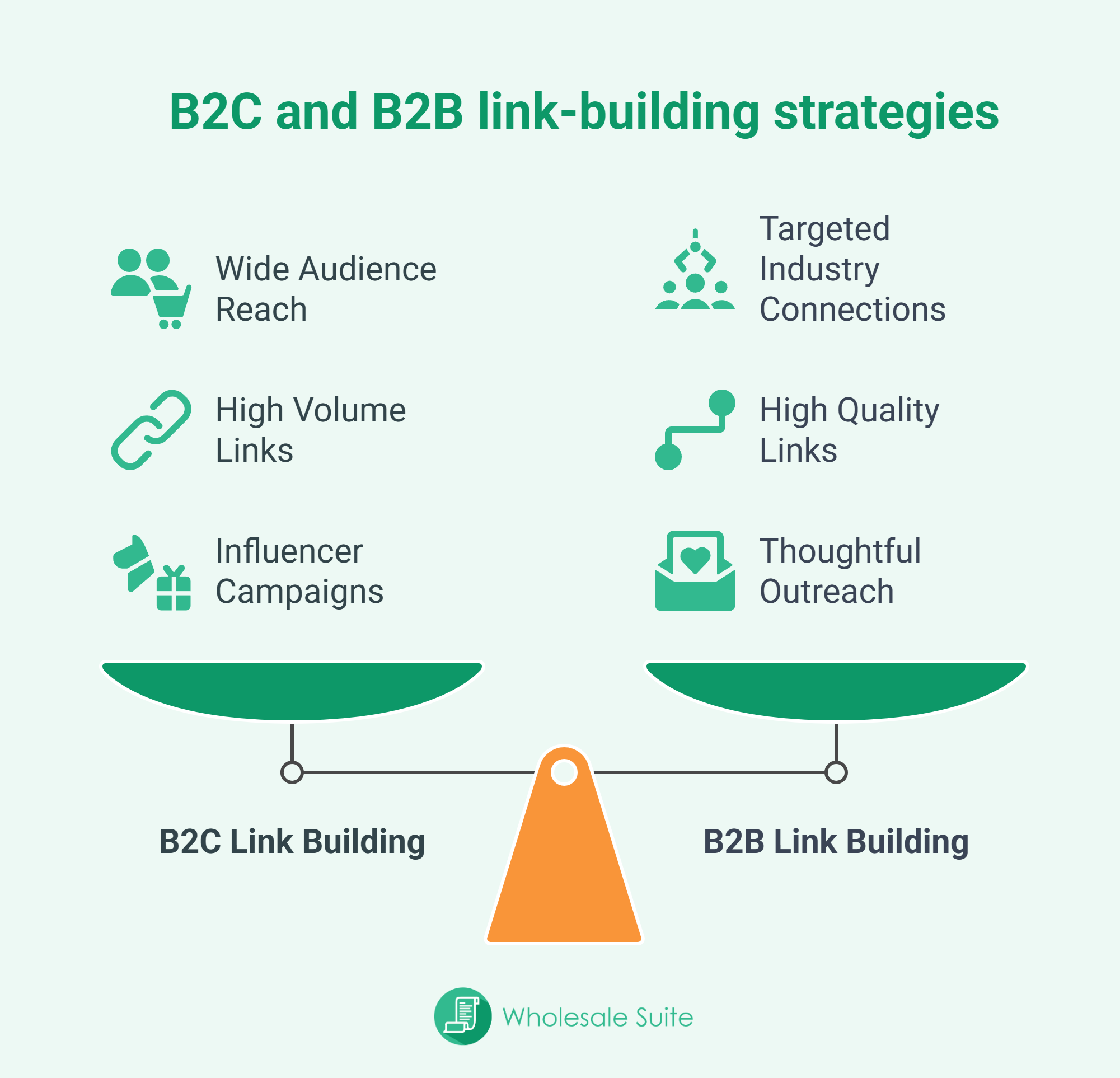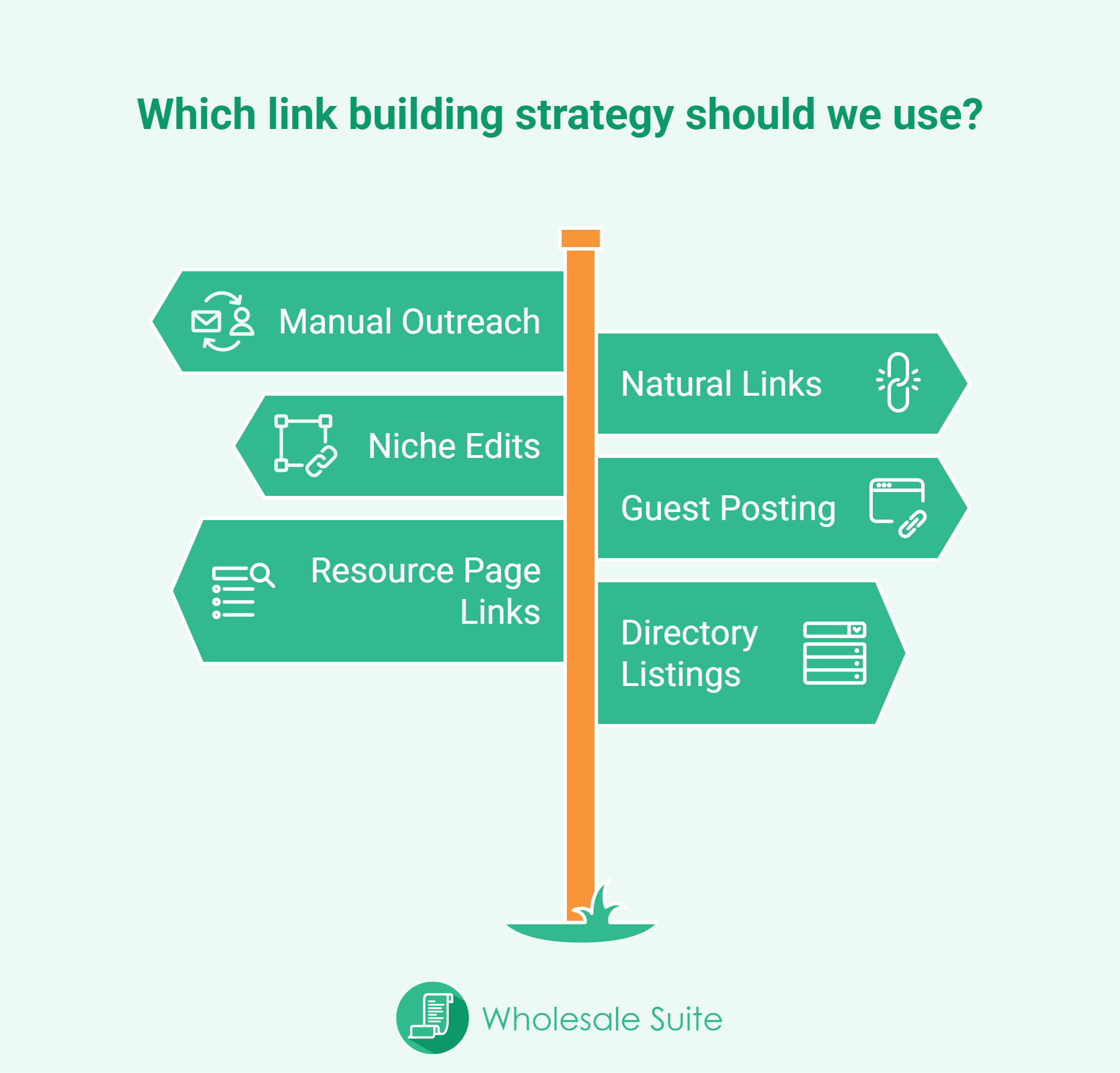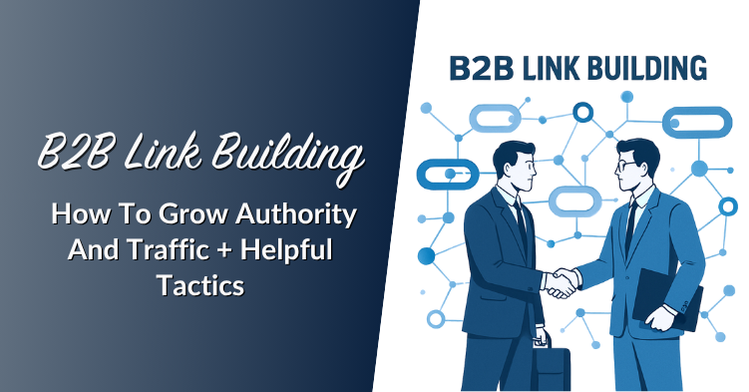
Link building might sound technical, but simply put, it’s just one website pointing to another. If your website receives links from trusted business websites, search engines will also start to view you as more reliable. That’s where B2B link building comes in. It helps your site gain authority and attract steady visitors, also known as referral traffic.
Good B2B link building doesn’t happen by chance. It follows a plan. You examine the types of link building that work for your business, select your best link building tactics, and create a system that aligns with your goals. This process helps you achieve better results over time, especially if you aim for more organic traffic from search engines.
In this guide, we’ll walk through everything you need to know: from what B2B link building really means, to how to create a smart strategy that works for your site. You’ll also learn about link building techniques, how to avoid common mistakes, and how to start building links that matter.
Let’s begin!
What Is B2B Link Building?
B2B link building means getting other business websites to link to your site. These links are also called backlinks. When another site links to you, it tells search engines that your content is helpful or trustworthy. This is especially important because you want to gain and attract traffic from business owners, managers, or decision-makers who are seeking what you offer. When Google or other search engines see these links, they use them as signals. It helps your pages rank higher.
That’s how B2B link building connects to SEO, and that’s why it plays a big part in getting more organic traffic. It’s not only about getting people to visit your site. It’s about getting the right people to visit and eventually trust your brand.
The difference between B2C and B2B link-building approaches
Most B2C link building efforts focus on achieving large numbers. The goal is to encourage as many people as possible to click and make a purchase. These links often come from popular blogs, news sites, or product review pages. It works because the audience is wide and the products are easy to understand.
But B2B link building works differently. Instead of trying to reach the masses, it focuses on fewer, more meaningful connections. You want links from websites that have authority in your specific industry. These might include SaaS blogs, service providers, or partner companies that target the same business audience. These links generate more targeted referral traffic and are more effective for long-term results.
Outreach is also different. B2C link building might involve influencer campaigns or sponsored posts. B2B, on the other hand, often involves sending thoughtful emails, offering helpful resources, or sharing research that another business would want to link to. The process takes time, but the quality of each link is more important.
Types Of Link Building
There are many ways to build links, but not all of them work the same way. In B2B link building, it’s essential to understand which methods are most effective for achieving your goals. The right types of link building can help you attract better visitors, establish more trust, and achieve long-term results.
Below are six common types of link building used in B2B:
1. Manual outreach links
Manual outreach links are established by sending emails to site owners and asking them to review your content. If they like it, they may link to it. This is one of the most common types of link building in B2B because it gives you some control. It works best when you offer something valuable and write clear, kind emails.
2. Natural links
Natural links happen when someone links to your page without you asking. This kind of link is earned by creating helpful and valuable content. If a business finds your guide helpful, they might link to it from their site. Search engines trust these links, but they take time and effort to get.
3. Niche edits
Niche edits occur when you insert a link into an existing article. You don’t write something new. Instead, you ask the site owner to add your link to a page they already have. This is one of the faster types of link building, but it only works well if the link is relevant and makes sense in the context of the article.
4. Guest posting
Guest posting is when you write for someone else’s blog or website and include a link back to yours. This approach works well when both sites target the same type of business audience. Guest posting is beneficial for building links and expanding your online presence. Make sure your content is high-quality and not merely written for the sake of the link.
5. Resource page links
Resource page links come from web pages that list tools, guides, or helpful articles. If your content aligns with the topic, you can request that the owner add your link. This is one of the smarter types of link building because you’re placing your content where people are already looking for help.
6. Directory listings
Directory listings are websites that list other businesses, tools, or services. These are easy to submit and can give quick backlinks. But not all directories are helpful. You should focus only on trusted directories in your field. Bad directories won’t help and might even hurt your link building efforts.
Link Building Tactics That Work
Clever link building tactics turn ideas into action. Below are tactics that you can easily follow and fit nicely inside a complete B2B link building plan.
Create helpful B2B content
First, write guides or case studies that answer fundamental questions: something widely searchable on Google or the internet that is related to your niche or business. Helpful content also attracts organic traffic, which in turn leads to an increase in links over time. Add neat charts, short videos, or simple checklists to make a lasting impression. Good content is the safest way to start link building campaigns that keep growing.
Send outreach emails with value
Next, build a short list of sites you respect. Write polite emails that show why your page helps their readers. Add one short line about what makes your data or story fresh. This approach works because it feels interpersonal yet direct. It is one of the most used link building techniques in B2B. Keep messages clear and track replies to improve future campaigns.
To give you a little push, here’s an example of an email template that you can use when you send out to your short list:
Example outreach email template:
Hi (name),
I came across your article on [Page Topic] and found it to be really useful. I noticed you’re linking to some helpful guides, so I wanted to share something that might also add value to your readers.
Recently, I published a post on [your Page Topic] that includes fresh data and a few examples people in [their audience type] have found helpful.
If you think it fits, feel free to check it out here: (your Link)
Either way, thanks for putting out great content. I learned a lot from your piece!
Best,
(Your Name)
Fix a broken link
A broken link is a dead link on a web page. Use free tools to find them on industry blogs. Then send the owner a quick note that points out the issue and offers your page as a fix. This tactic helps both sides. You give the owner an easy repair, and you gain a new backlink. Because everyone wins, broken-link outreach often gets a fast yes.
Answer journalists through HARO
After that, sign up for Help a Reporter Out (HARO) or similar services. Reporters ask for short quotes. Provide clear answers, include a statistic, and mention your role. When the story goes live, it links to your site. These links often sit on high-authority news pages. They drive good referral traffic and lift trust signals for search engines.
Show social proof and case studies
Finally, share real success stories. Short case studies demonstrate that your product or idea is effective. When partners feature these wins, there is a high chance that they might link back. Pair each story with solid numbers so that other sites can see the value in sharing it. This sparks more backlinks through word of mouth.
For your reference, you may read these case studies about Wholesale Suite store owners:
Using these five link building tactics together forms strong building campaigns. Follow them step by step, and your broader B2B link building strategy will grow in a steady, safe way.
How To Create A B2B Link Building Strategy
A good B2B link building strategy helps you save time, track wins, and build links that bring real value. Here’s how to do it:
Set goals you can track
Start by choosing what you want to improve. Do you want more organic traffic? More leads from search? More links to your blog posts? Write your goals down so you can measure them later. Having a goal makes it easier to choose the right link building tactics.
Pick the best tactics for your brand
Not every tactic fits every business. If you’re a software company, you might focus on writing case studies or guides. If you sell tools to other stores, directory listings and guest posts may be more effective. Think about what makes sense for your niche and what your audience wants. That’s how you build the right link building campaigns.
Choose websites that make sense
Now, it’s time to list websites you want links from. Choose websites that already talk to your audience. Look for ones that publish blogs, lists, or roundups. These are great spots for external linking, guest posts, or even outreach to broken links. A short list of good targets is preferable to a lengthy list of random sites.
Send messages that feel personal
Use the email template we shared earlier, but make it personal each time. Say why you’re reaching out and what’s in it for them. Never send mass emails that appear to be spam. The more real you sound, the more replies you’ll get. Good outreach is one of the top link building techniques in any B2B link building strategy.
Track results and follow up
Use a simple spreadsheet or tool to keep track of who you contacted, what you said, and when you said it. Follow up politely if there’s no reply after a few days. Over time, you’ll see which building tactics work best for you. This helps improve your next batch of emails, allowing you to focus on what yields the best results.
What Most People Get Wrong About B2B Link Building
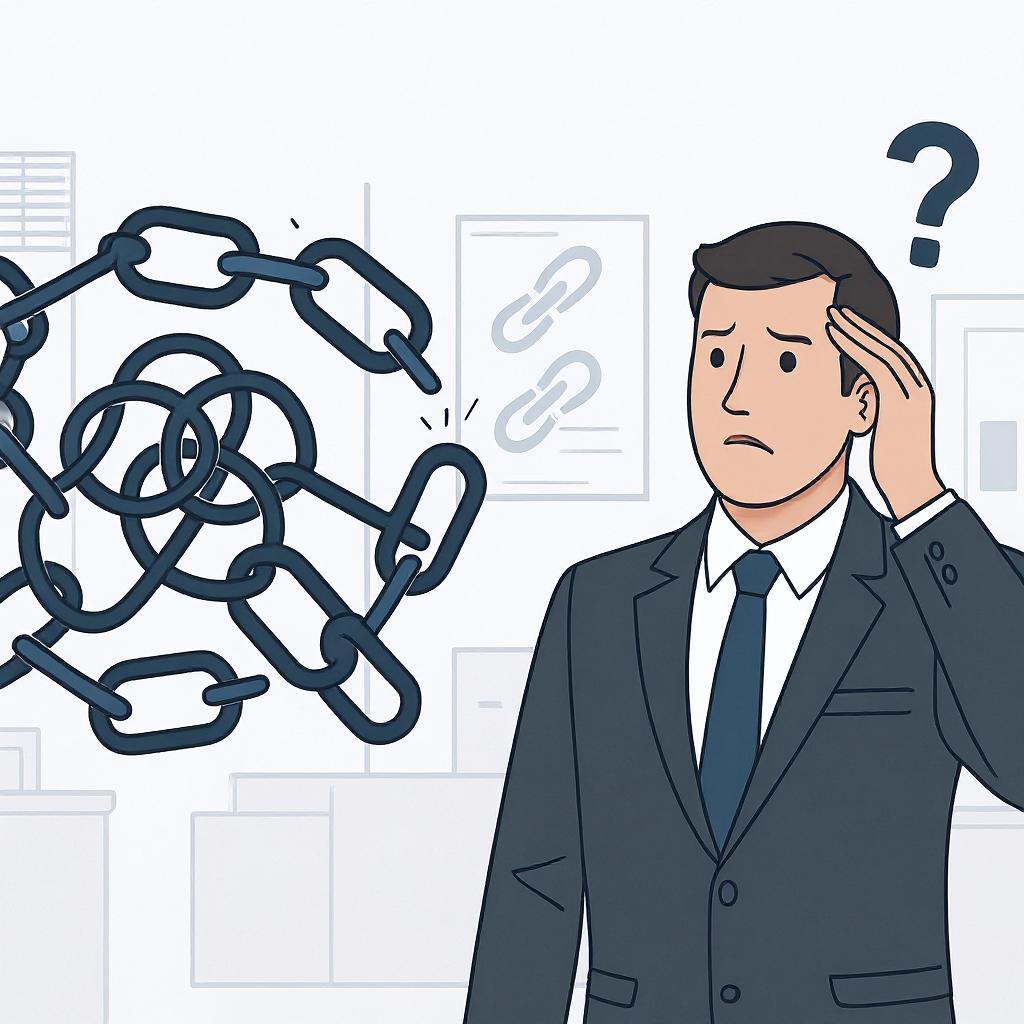
Even with a good plan, it’s easy to slip up. Here are the most common errors and how to avoid them:
Buying low-quality links
It might be tempting to pay for backlinks, especially when someone promises fast results. However, many paid links originate from spammy sites that lack genuine traffic. These links can actually harm your SEO instead of benefiting it. It’s always better to build real, honest links using trusted link building tactics.
Ignoring niche relevance
A good backlink comes from a site that’s related to your field. If you run a B2B tool for shipping companies, a link from a recipe blog won’t help. But a link from a supply chain blog will. B2B link building is most effective when the links are relevant and make sense. Stick with websites that share your audience or discuss topics related to your industry.
Using the same anchor text repeatedly
Anchor text is the clickable part of a link. If all your links say the exact same thing, search engines might think you’re trying to cheat the system. Mix it up. Use your brand name, the page title, or short phrases that match the content. This makes your link building campaigns look more natural.
Not tracking progress
If you don’t track which tactics work, you won’t know what to fix or improve. Make a list of each link you earn, the website it came from, and the result. Did you get more referral traffic? Did your blog rank higher? This step helps shape a better B2B link building strategy over time.
What To Do After You Start Building Links
If you want your B2B link building efforts to remain effective in the long term, you need to do more than just acquire a few backlinks. You must stay consistent, continue learning, and employ smart building tactics that grow over time. Here are some tips to help you stay ahead of the game:
Stay updated on Google’s rules
Search engines frequently update their ranking algorithms. What worked last year might not work today. Always check trusted blogs or SEO news to see if there are new rules about link building. If you follow updates, you’ll know which link building techniques are safe and which ones can hurt your site.
Focus on real value
Ask yourself: “Would I link to this if I didn’t own the site?” If the answer is no, then you may need to improve your page first. The best link building tactics start with useful, honest content. It doesn’t need to be perfect, but it should be helpful to your target audience.
Be patient and stay consistent
B2B link building is not a one-week project. It takes time. Most of the best backlinks come from steady work, not shortcuts. Send a few outreach emails every day. Build your list slowly. Keep track of your wins. Over time, your internal linking will grow stronger and your authority will improve.
If you’re running a wholesale store, having the right tools can make link building easier. That’s where Wholesale Suite comes in. It helps you organize your products, manage wholesale pricing, and make your store more useful for business buyers.
You may also read: The Ultimate Guide To Launching A Successful WooCommerce B2B Store.
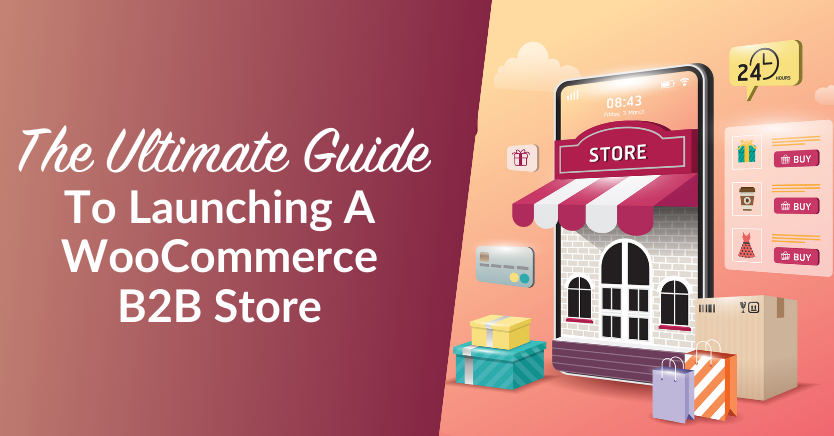
For example, if your store has a smooth order form, clear product categories, and pricing that works for bulk buyers, other business sites may use you as a reference. They might link to your product pages, blog content, or resources because it also helps their audience. These are the kinds of links that establish your authority without requiring you to ask for them. That’s why building a strong site experience with tools like Wholesale Suite supports your long-term B2B link building goals.
Frequently Asked Questions
What is link building in marketing?
Link building in marketing means getting other websites to link to yours. These links help people find your site and tell search engines that your content is useful. In B2B link building, the goal is to acquire links from trusted business sites that target the same audience as you. These links can help your pages rank higher, bring in referral traffic, and grow your organic traffic, too. It’s one of the most used link building tactics because it supports long-term growth.
Which technique is most effective for link building?
There isn’t just one perfect method. But in B2B, some link building techniques work better than others. Guest posting, broken link outreach, and sharing useful case studies are some of the best tactics. These methods bring in high-quality links and also establish your business as trustworthy and genuine. The most effective technique depends on your audience, but helpful content plus smart outreach is a good place to start.
What are the rules of effective link building?
Good link building should follow a few simple rules. First, focus on quality over quantity. A few good links from trusted websites are better than many from random ones. Second, don’t buy links. They can hurt your SEO. Third, keep your link building campaigns honest and helpful. Use real value to earn links, not shortcuts. And always mix your tactics! Utilize content, outreach, internal linking, and resources that other sites would like to mention.
Takeaways
B2B link building is not about chasing quick wins. It’s about building genuine connections, offering value, and establishing the kind of links that help your business thrive over time. From selecting the right types of link building to employing the most effective link building tactics, every step works together to help you gain visibility, trust, and attract the right audience.
In this article, we discussed everything you need to know about how b2b link building works:
- What is B2B link building
- Types of link building
- Link building tactics that work
- How to create a B2B link building strategy
- Common mistakes
- What comes next
If you’re just starting out, try one tactic at a time. Perhaps start by creating helpful content or fixing a broken link on another site. As you see what works, you can build stronger link building campaigns and use your own data to guide your next steps. Whether you’re focused on growing referral traffic, ranking higher, or helping more people find your products, a clear and honest B2B link building strategy will get you there.
For wholesale businesses, having a helpful site makes a huge difference. That’s why tools like Wholesale Suite matter. They help your store become more valuable, which in turn makes other businesses more likely to link to you. When you focus on delivering real value, crafting strong content, and implementing smart internal linking, your authority grows naturally without relying on tricks. Why don’t you give it a try now?
If you have any further questions about B2B link building, please leave a comment below, and we’ll be happy to help you out!


